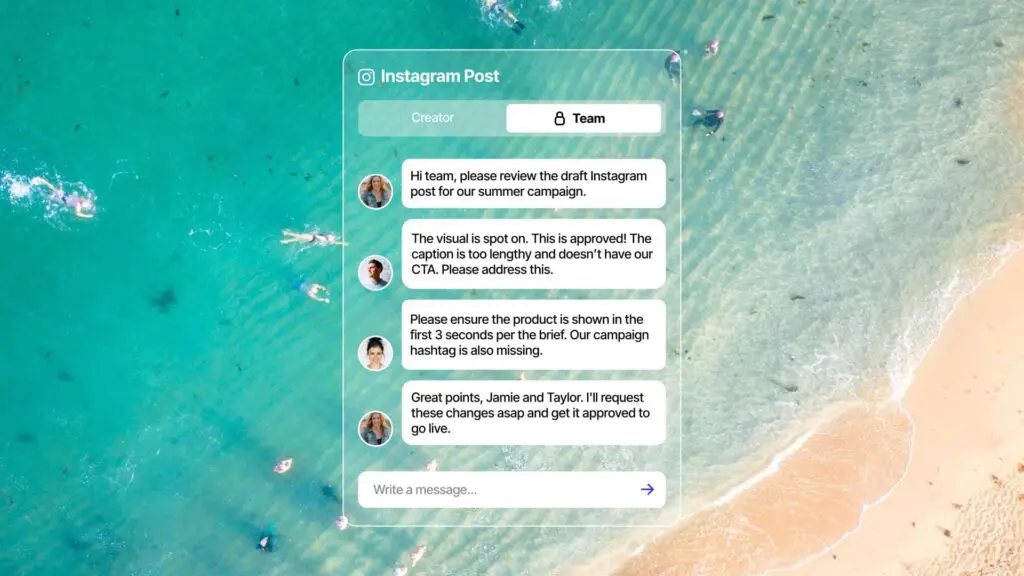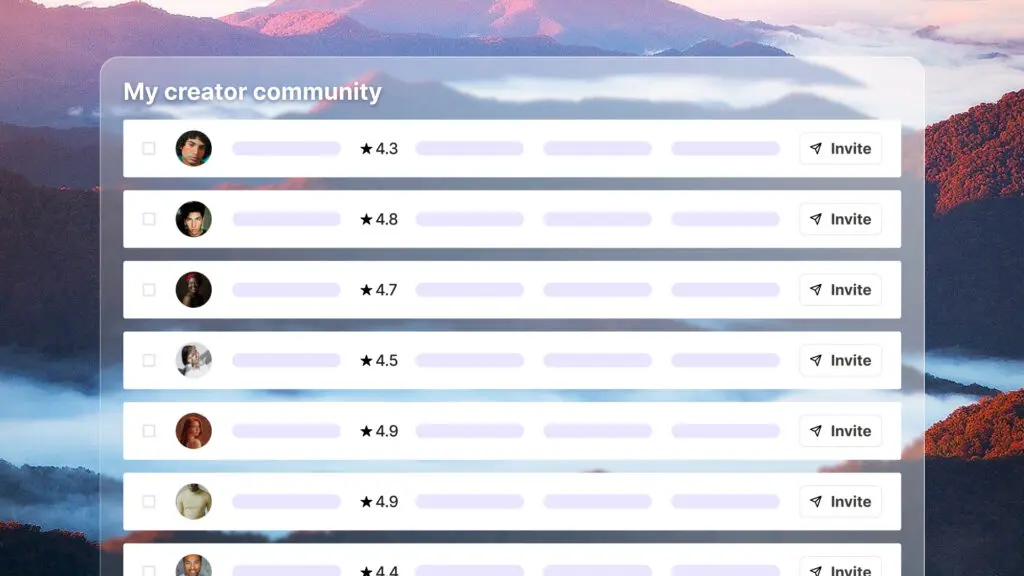

However, until recently, other fast-moving consumer goods (FMCG), or consumer packaged goods (CPG) as they’re sometimes known, have mainly been promoted using traditional advertising.
Brands are now recognizing that influencer marketing can be an extremely effective way of driving sales for most FMCG, including food & beverages, toiletries, stationery, and supplements. According to Zemfo, FMCG brands now spend more money on influencer marketing than any other sector does.
Influencer marketing is the process of collaborating with a person who has a relevant, prominent, and engaged following on social media, so that they promote your brand to their audience.
An influencer creates their own content. They are often happy to devise campaigns in collaboration with brands in return for a fee. The advantage of this kind of marketing is that influencers have highly engaged audiences who trust the influencer’s opinions and recommendations.
Influencer marketing is an effective strategy for FMCG brands of all sizes. Some of the smaller (or ‘nano’ influencers) charge relatively little per post – usually a few hundred pounds. They don’t have the follower count that celebrity or mega-influencers do, but their audiences are often highly engaged.

The FMCG market represents a huge chunk of the global economy and with it comes specific challenges that marketers need to navigate.
Consumer preferences evolve constantly, so it’s important to stay ahead of market trends, keep an eye on health news, and monitor sustainability issues. For example, where single-use plastic was once perfectly acceptable for FMCG goods, things have changed and it’s now enough to stop some consumers from buying a product.
How influencer marketing can help
When it comes to consumer preferences, influencers have got their fingers on the pulse. They’re engaging with their audience on a daily basis so have a pretty solid idea of what they find acceptable, what they don’t, and what the current trends are.
There’s intense competition in the fast-paced world of FMCG, with a huge number of brands vying for a share of the market. To survive, brands need to differentiate, innovate, and market effectively.
How influencer marketing can help
This is where influencer marketing comes into its own. There’s a certain kudos that comes with being recommended by an influencer, even when, as rules dictate, social media users know that the content they’re viewing is sponsored. It’s usually assumed that influencers only work with brands they genuinely love.
Raw material prices are spiralling upwards, presenting huge challenges for FMCG brands. Price point has become more relevant than ever, and if you’re marketing something that isn’t as competitively priced as other brands, you’ll need to give consumers a really good reason for choosing your product over cheaper versions.
How influencer marketing can help
By communicating with your target demographic in a highly personalised way, influencers can help inspire loyalty for your brand among their followers, and stretch your brand value far beyond price point.

Below are just some of the many benefits of influencer marketing for FMCG brands:
To learn more about how social media can boost your business, check out our guide to social commerce.
Influencer marketing works, which is why 38% of FMCG marketers spend 20% of their marketing budgets on it. In fact, it’s so effective, some brands are appointing big name influencers to their internal teams – in 2022, Kate Moss was made creative director of Diet Coke ahead of the brand’s 40th anniversary.
Here’s a few examples of successful FMCG influencer campaigns:
Dove expanded its influencer marketing in 2022 in a bid to spread its brand values of body confidence and inclusivity. It ran several micro-influencer campaigns using #DetoxYourFeed to highlight toxic beauty values, and #OneRealPressure to encourage people to share their stories of early motherhood. The campaign garnered 1 million impressions across social platforms, and engagement went up by 20%. It’s the perfect example of how influencer marketing can build trust, engender emotions, and demonstrate strong brand ethics.
Vlogger Logan Paul was chosen to launch the energy drink Prime in 2022 along with fellow YouTuber KSI. The campaign was such a success that stores ran out of the £1.99 sports drinks. A bottle of it was listed on eBay for £10,000, and even more shockingly, teens were getting up at 6am to queue outside supermarkets for it.
Cadbury’s worked with influencers to drum up awareness of the new Cadbury Dark Milk Chocolate. The campaign attracted more than 20,000 likes and follows.
Want to know how your brand is being received online? Find out with our rundown on social listening.

It’s possible to find influencers organically by searching competitors and using hashtags, but it will take up a lot of your time. The easiest and most effective way to find FMCG influencers is to use a platform such as Vamp, where you can find the right influencers, manage all your projects, and scrutinise analytics all in one place.
Vamp will connect you to genuine influencers (our rule is one of invite only) and enable you to generate campaigns that will spark conversation, drive brand awareness, and create engagement. The platform also provides you with real-time metrics on how your campaign is performing.
The following social media channels are the best for FMCG/CPG influencer marketing:
You can’t use a one-size-fits-all approach with influencer marketing, as you need to show up where your target audience is hanging out.
According to Sprout Social:
Meta’s Hot Topics will keep you informed of the latest trends and talking points on Facebook and Instagram.
Learn more with our comprehensive piece on social media for businesses.

When building your FMCG/CPG influencer marketing campaign, these are the factors you need to consider:
For a more in-depth dive into strategy, take a look at our guide to influencer marketing strategy. You’ll also find our article on the difference between influencers and creators of interest.
It’s vital that you track your FMCG influencer campaign, so that you know what’s worked and what hasn’t. You can then use these findings to influence subsequent campaigns. The metrics you can choose to track include:
Drill down into the metrics so that you get a clear vision of all the variables. For example, did an Instagram post drive more traffic than a reel? What was the conversion rate of a specific discount code?, etc.
Are you keen to launch an effective FMCG influencer campaign? Get started with Vamp. There’s a budget to suit all businesses and we have all the expertise you need to create a killer campaign.



| Cookie | Duration | Description |
|---|---|---|
| __cf_bm | 30 minutes | This cookie, set by Cloudflare, is used to support Cloudflare Bot Management. |
| _abck | 1 year | This cookie is used to detect and defend when a client attempt to replay a cookie.This cookie manages the interaction with online bots and takes the appropriate actions. |
| _GRECAPTCHA | 5 months 27 days | This cookie is set by the Google recaptcha service to identify bots to protect the website against malicious spam attacks. |
| bm_sz | 4 hours | This cookie is set by the provider Akamai Bot Manager. This cookie is used to manage the interaction with the online bots. It also helps in fraud preventions |
| cookielawinfo-checkbox-advertisement | 1 year | Set by the GDPR Cookie Consent plugin, this cookie is used to record the user consent for the cookies in the "Advertisement" category . |
| cookielawinfo-checkbox-analytics | 11 months | This cookie is set by GDPR Cookie Consent plugin. The cookie is used to store the user consent for the cookies in the category "Analytics". |
| cookielawinfo-checkbox-functional | 11 months | The cookie is set by GDPR cookie consent to record the user consent for the cookies in the category "Functional". |
| cookielawinfo-checkbox-necessary | 11 months | This cookie is set by GDPR Cookie Consent plugin. The cookies is used to store the user consent for the cookies in the category "Necessary". |
| cookielawinfo-checkbox-others | 11 months | This cookie is set by GDPR Cookie Consent plugin. The cookie is used to store the user consent for the cookies in the category "Other. |
| cookielawinfo-checkbox-performance | 11 months | This cookie is set by GDPR Cookie Consent plugin. The cookie is used to store the user consent for the cookies in the category "Performance". |
| CookieLawInfoConsent | 1 year | Records the default button state of the corresponding category & the status of CCPA. It works only in coordination with the primary cookie. |
| csrftoken | past | This cookie is associated with Django web development platform for python. Used to help protect the website against Cross-Site Request Forgery attacks |
| elementor | never | This cookie is used by the website's WordPress theme. It allows the website owner to implement or change the website's content in real-time. |
| viewed_cookie_policy | 11 months | The cookie is set by the GDPR Cookie Consent plugin and is used to store whether or not user has consented to the use of cookies. It does not store any personal data. |
| Cookie | Duration | Description |
|---|---|---|
| __hssc | 30 minutes | HubSpot sets this cookie to keep track of sessions and to determine if HubSpot should increment the session number and timestamps in the __hstc cookie. |
| __hssrc | session | This cookie is set by Hubspot whenever it changes the session cookie. The __hssrc cookie set to 1 indicates that the user has restarted the browser, and if the cookie does not exist, it is assumed to be a new session. |
| __hstc | 5 months 27 days | This is the main cookie set by Hubspot, for tracking visitors. It contains the domain, initial timestamp (first visit), last timestamp (last visit), current timestamp (this visit), and session number (increments for each subsequent session). |
| _ga | 2 years | The _ga cookie, installed by Google Analytics, calculates visitor, session and campaign data and also keeps track of site usage for the site's analytics report. The cookie stores information anonymously and assigns a randomly generated number to recognize unique visitors. |
| _ga_56JWQ0019V | 2 years | This cookie is installed by Google Analytics. |
| _gat_UA-132076027-1 | 1 minute | A variation of the _gat cookie set by Google Analytics and Google Tag Manager to allow website owners to track visitor behaviour and measure site performance. The pattern element in the name contains the unique identity number of the account or website it relates to. |
| _gcl_au | 3 months | Provided by Google Tag Manager to experiment advertisement efficiency of websites using their services. |
| _gid | 1 day | Installed by Google Analytics, _gid cookie stores information on how visitors use a website, while also creating an analytics report of the website's performance. Some of the data that are collected include the number of visitors, their source, and the pages they visit anonymously. |
| bscookie | 1 year | LinkedIn sets this cookie to store performed actions on the website. |
| CONSENT | 2 years | YouTube sets this cookie via embedded youtube-videos and registers anonymous statistical data. |
| hubspotutk | 5 months 27 days | HubSpot sets this cookie to keep track of the visitors to the website. This cookie is passed to HubSpot on form submission and used when deduplicating contacts. |
| Cookie | Duration | Description |
|---|---|---|
| _fbp | 3 months | This cookie is set by Facebook to display advertisements when either on Facebook or on a digital platform powered by Facebook advertising, after visiting the website. |
| _pin_unauth | 1 year | This cookie is placed by Pinterest Tag when the user cannot be matched. It contains a unique UUID to group actions across pages. |
| AnalyticsSyncHistory | 1 month | No description |
| bcookie | 1 year | LinkedIn sets this cookie from LinkedIn share buttons and ad tags to recognize browser ID. |
| bscookie | 1 year | LinkedIn sets this cookie to store performed actions on the website. |
| fr | 3 months | Facebook sets this cookie to show relevant advertisements to users by tracking user behaviour across the web, on sites that have Facebook pixel or Facebook social plugin. |
| IDE | 1 year 24 days | Google DoubleClick IDE cookies are used to store information about how the user uses the website to present them with relevant ads and according to the user profile. |
| lang | session | LinkedIn sets this cookie to remember a user's language setting. |
| lidc | 1 day | LinkedIn sets the lidc cookie to facilitate data center selection. |
| MONITOR_WEB_ID | 3 months | The cookie is used by: TikTok The functionality is: to store if the user has seen embedded content. The purpose is: Marketing/Tracking |
| test_cookie | 15 minutes | The test_cookie is set by doubleclick.net and is used to determine if the user's browser supports cookies. |
| ttwid | 1 year | No description available. |
| UserMatchHistory | 1 month | LinkedIn sets this cookie for LinkedIn Ads ID syncing. |
| VISITOR_INFO1_LIVE | 5 months 27 days | A cookie set by YouTube to measure bandwidth that determines whether the user gets the new or old player interface. |
| YSC | session | YSC cookie is set by Youtube and is used to track the views of embedded videos on Youtube pages. |
| yt-remote-connected-devices | never | YouTube sets this cookie to store the video preferences of the user using embedded YouTube video. |
| yt-remote-device-id | never | YouTube sets this cookie to store the video preferences of the user using embedded YouTube video. |
| yt.innertube::nextId | never | This cookie, set by YouTube, registers a unique ID to store data on what videos from YouTube the user has seen. |
| yt.innertube::requests | never | This cookie, set by YouTube, registers a unique ID to store data on what videos from YouTube the user has seen. |
| Cookie | Duration | Description |
|---|---|---|
| li_gc | 5 months 27 days | No description |
| ln_or | 1 day | No description |
| msToken | 10 days | No description |
| wp-wpml_current_language | session | No description available. |